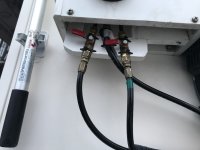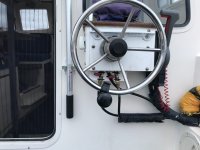And here we go again. It worked, for a bit. But I'm right back to the same exact problem. I was thinking of checking my hydraulic hoses for any kinks to see if there was some restriction. But the more I thought about it, the more it seems this issue has to be in the helms. Low and behold I think I finally got a possible answer. I was going to post again on Hull Truth looking for some information, and when I logged on I found I had a private message. (If anyone knows how to turn on a switch to make Hull Truth notify me of new messages, please let me know.) It sounds reasonable, but I have not been able to find the part listed anywhere.
The symptom you are describing with your steering occurs on single engine boats with two helms at a similar vertical height. The unbalanced prop torque creates a positive pressure in the lines in one direction, and a slight suction effect in the other direction, which pulls the helm check valves off their seat a tiny bit. When you steer slowly enough to starboard the fluid can come back through the check valve of the second helm and return to the first helm through the compensation line. If you steer quickly you will generate enough pressure to close that second check valve and it will steer normally, as you've noticed. (You can also give it a quick snap, then steer slowly and it will work. That doesn't help your AP though.)
We've traditionally recommended Pro helms for this application, because they have a different check valve design that pressurizes the steering lines and keeps the check valves firmly seated. However, we are releasing a simple add-on kit soon that will work with standard helms. The kit part number is HA5500. It will take some time for it to percolate through distribution and be available at your local dealer (you probably won't be able to order one until closer to the end of September). I don't have pricing, but it will certainly be less than the cost of a new helm. Installation should take a marine mechanic no more than half an hour, including bleed time. There's no reason you couldn't do it yourself, but bleeding the system will be faster and easier with a power purge device that most dealers will have.
While it may seem that we are just trying to sell more stuff, this bypassing is a simple consequence of physics and isn't a defect.
Additional background FYI: If the second helm is much higher than the first (on a flybridge, say) then there is enough static head (pressure) in the lines to counter the suction effect, so we don't see this bypassing. It also doesn't happen on twin engine setups, because there is no unbalanced prop torque with counter-rotating props.


